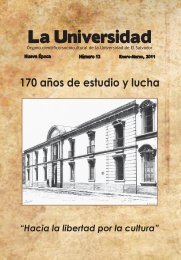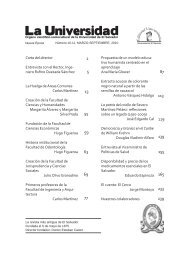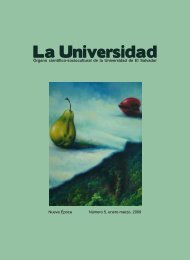- Page 2 and 3:
Carta del director Prefacio Héctor
- Page 4 and 5:
Carta del director Tres preguntas b
- Page 6 and 7:
Prefacio En el marco de la conmemor
- Page 8 and 9:
construyeron las más importantes a
- Page 10 and 11:
Prólogo a la presente edición Pre
- Page 12 and 13:
A manera de prólogo En nuestro pa
- Page 14 and 15:
es privados, se dieran a la tarea d
- Page 16:
multidisciplinario en la protecció
- Page 19 and 20:
pbell 1988:275-279; Dakin, 2001: 36
- Page 21 and 22:
tache y Cobean, 2000; 2001; Mastach
- Page 23 and 24:
un panel que lleva una serie de med
- Page 25 and 26:
24 La Universidad Figura 4. Grupo L
- Page 27 and 28:
alto y cuello corto; tecomates y ja
- Page 29 and 30:
Figura 9. García Rojo. a, plato; b
- Page 31 and 32:
Jején Policromo sobre Rojo (Figura
- Page 33 and 34:
frecuentemente en forma de vasijas
- Page 35 and 36:
tivamente fina es cubierta con un e
- Page 37 and 38:
decorativos y características tecn
- Page 39 and 40:
dirigidos por Bruhns [1980], Fowler
- Page 41 and 42:
de Santa María, derivados del prog
- Page 43 and 44:
plejo es una pirámide de aproximad
- Page 45 and 46:
ocupación. Este hecho nos alerta s
- Page 47 and 48:
las dinastías reales, todos los gr
- Page 49 and 50:
Podemos estar seguros, entonces, de
- Page 51 and 52:
tectura y la cultura material entre
- Page 53 and 54:
grantes, quizá, agregaría nuevas
- Page 55 and 56:
país del postclásico tardío, qui
- Page 57 and 58:
An Early PostclassicTown of El Salv
- Page 59 and 60:
Historia, México; University of Pi
- Page 61 and 62:
Fowler, William R., Jr., y E. Marga
- Page 63 and 64:
León-Portilla, Miguel [1980]. Tolt
- Page 65 and 66:
Münch Galindo, Guido [1983]. Etnol
- Page 67 and 68:
de Tula: Excavaciones recientes en
- Page 69 and 70:
En el presente artículo se analiza
- Page 71 and 72:
fueron sitios ya registrados que se
- Page 73 and 74:
por la topografía de la lengüeta.
- Page 75 and 76:
tribuidos sobre el sector más ango
- Page 77 and 78:
cuales forman una pequeña plaza. E
- Page 79 and 80:
ciones y transformaciones son el pr
- Page 81 and 82:
como, por ejemplo, en la ropa, deco
- Page 83 and 84:
troamérica. Conjuntamente, las car
- Page 85 and 86:
lugar de eventual retorno, un lugar
- Page 87 and 88:
migratorias de los grupos nahuapipi
- Page 89 and 90:
mo, El Salvador». Informe inédito
- Page 91 and 92:
Tambiah, Stanley J. [2000]. «Trans
- Page 93 and 94:
pueden ser útiles para señalar id
- Page 95 and 96:
Cholula [McCafferty 1989, 2003, 200
- Page 97 and 98:
sabemos que lo que había sido reco
- Page 99 and 100:
Cafferty, 2008]. De particular inte
- Page 101 and 102:
eflejar etnicidad, entre otras cual
- Page 103 and 104:
102 La Universidad Figura 6: Joyer
- Page 105 and 106:
servación y a la perturbación por
- Page 107 and 108:
este propósito, pero incensarios e
- Page 109 and 110:
tral Mexican Imagery in Greater Nic
- Page 111 and 112:
Graham and Jeff Kowalski (eds.). Wa
- Page 113 and 114:
Stark, Barbara L. [2008]. «Archaeo
- Page 115 and 116:
ción de carretera —el bypass de
- Page 117 and 118:
Fase Irarraga (postclásico tardío
- Page 119 and 120:
118 La Universidad Figura 1. Estruc
- Page 121 and 122:
120 La Universidad Figura 3. Plano
- Page 123 and 124:
122 La Universidad Figura 5. Rasgo
- Page 125 and 126:
carbonizados de huesos de animales.
- Page 127 and 128:
126 La Universidad Figura 7. Mapa d
- Page 129 and 130:
128 La Universidad Figura 8. Mapa e
- Page 131 and 132:
130 La Universidad Figura 10. Perfi
- Page 133 and 134:
c A.D. 1540». En Land and Politics
- Page 135 and 136:
nalizadas, lo cual es un importante
- Page 137 and 138:
La propiedad ha sido moderadamente
- Page 139 and 140:
138 La Universidad Figura 4. Levant
- Page 141 and 142:
carece de fecha, sin embargo, otras
- Page 143 and 144:
Los antecedentes regionales relacio
- Page 145 and 146:
Se ubican 14 operaciones más en al
- Page 147 and 148:
II, compuesta de tierra café oscur
- Page 149 and 150:
Tabla 1: Vista global de datos cuan
- Page 151 and 152:
150 La Universidad Gráfico 3. Eje
- Page 153 and 154:
Figura 7. Plano de densidades cuenc
- Page 155 and 156:
Los fragmentos recuperados también
- Page 157 and 158:
lor verdoso oscuro o negro, con dis
- Page 159 and 160:
En primer lugar, es interesante des
- Page 161 and 162:
cerámica en negativo Usulután rec
- Page 163 and 164:
atribuyendo ornamentos como collar,
- Page 165 and 166:
fragmentos de mano con formas recta
- Page 167 and 168: conjunto presenta una orientación
- Page 169 and 170: Figura 9. Orientación morfológica
- Page 171 and 172: Figuras 12. Llano de Atalaya. (a) Z
- Page 173 and 174: que se localiza Atalaya está limit
- Page 175 and 176: En ninguna de las 66 operaciones re
- Page 177 and 178: 176 La Universidad Figura 16. Sitio
- Page 179 and 180: desarrollaron otras característica
- Page 181 and 182: A.C. Suasnávar y B. Arroyo), pp.1-
- Page 183 and 184: nology. Cambridge: Harvard Universi
- Page 185 and 186: nistración del Patrimonio Cultural
- Page 187 and 188: sondeo en diferentes áreas, con el
- Page 189 and 190: 188 La Universidad Figura 2. Mapa t
- Page 191 and 192: plaza y la estructura se integraron
- Page 193 and 194: Figura 4. Comparación de Dimension
- Page 195 and 196: Metodología empleada en el anális
- Page 197 and 198: mencionar que se crearon varios gru
- Page 199 and 200: Figura 7. Muestra Ceramica del Comp
- Page 201 and 202: en La Laguneta forman parte de un p
- Page 203 and 204: más ‘mesoamericanos’, los cual
- Page 205 and 206: Ofrendas Lepa Depósitos especiales
- Page 208 and 209: Resumen de las investigaciones geof
- Page 210 and 211: Figura 1. Mapa de Lotes 190-192, al
- Page 212 and 213: niveló el lugar hasta el punto en
- Page 214 and 215: uscando troncos de vegetación semb
- Page 216 and 217: Rethinking southeast Maya agricultu
- Page 220 and 221: nature of farming choices including
- Page 222 and 223: epresent the autonomous choices and
- Page 224 and 225: discovered in a road cut in 2009 (F
- Page 226 and 227: of Joya de Cerén, El Salvador». E
- Page 228: --------------- [2003]. «New Direc
- Page 231 and 232: La falta de evidencia de un cultivo
- Page 233 and 234: Figura 4. Mapa de la zona del proye
- Page 235 and 236: Plataforma nivelada Tres de las ope
- Page 237 and 238: 236 La Universidad Figura 7. Molde
- Page 239 and 240: 238 La Universidad Figura 11. Mapa
- Page 241 and 242: una capa de tierra blanca joven, te
- Page 243 and 244: 242 La Universidad Conclusión La i
- Page 246 and 247: Transformaciones de identidad en El
- Page 248 and 249: al., 2007], excavaciones extensas d
- Page 250 and 251: Figura 1. Mapa de las calles, cuadr
- Page 252 and 253: según los documentos históricos,
- Page 254 and 255: utilizaron conceptos de diseño de
- Page 256 and 257: por una sobrecarga de 33 %, se hubi
- Page 258 and 259: Mayólica La ‘mayólica’ (cerá
- Page 260 and 261: tando las formas de las vasijas eur
- Page 262 and 263: Implicaciones de la cronología ext
- Page 264 and 265: vo ocupada por casi el doble del ti
- Page 266 and 267: 14; Sampeck, 2007; Sharer, 1978: 60
- Page 268 and 269:
Figura 12. Mapa de las excavaciones
- Page 270 and 271:
encontrarse en la historia de la vi
- Page 272 and 273:
La interacción entre las casas de
- Page 274 and 275:
Tabla 1. Operación 3D2. Porcentaje
- Page 276 and 277:
la Villa de San Salvador, El Salvad
- Page 278 and 279:
The South Carolina Institute of Arc
- Page 280 and 281:
James, Stephen R., Jr. [1988]. «A
- Page 282 and 283:
Museum of Art in association with P
- Page 284 and 285:
El hierro de la tierra del Reino de
- Page 286 and 287:
y 2003 [Fowler, 2002, 2003]. Lo má
- Page 288 and 289:
dentro de los terrenos de la Finca
- Page 290 and 291:
Enrique de Sessi y Julbi era parte
- Page 292 and 293:
como es el año de 1801, en que se
- Page 294 and 295:
guos, pero este ya no se encontraba
- Page 296 and 297:
en posesión de Antonio Martínez.
- Page 298 and 299:
arquitectónicos y de ingeniería h
- Page 300 and 301:
muy difícil para que fuera visitad
- Page 302 and 303:
Consideraciones Finales Los product
- Page 304:
charlas. Sofía Mata (coord.). San
- Page 307 and 308:
Figura 1. Mapa de El Salvador indic
- Page 309 and 310:
[1997] encontraron unos tiestos del
- Page 311 and 312:
310 La Universidad Figura 3. Fotogr
- Page 313 and 314:
séptimo siglo d.C. Es muy probable
- Page 315 and 316:
Dull, Robert A., John R. Southon y
- Page 318 and 319:
Visitas a los sitios de arte rupest
- Page 320 and 321:
Salvador (UES) nos había proporcio
- Page 322 and 323:
de la jurisdicción de Guaymango. D
- Page 324 and 325:
atestigua una carta dirigida por el
- Page 326 and 327:
Figura 5. Dibujo de los petrograbad
- Page 328 and 329:
Figura 9. El abrigo rocoso de Las C
- Page 330 and 331:
Figura 13. Petrograbado de Las Cari
- Page 332 and 333:
mún en El Salvador. En la Piedra S
- Page 334 and 335:
a de los límites del abrigo. Todo
- Page 336 and 337:
asociados, en el corpus de sitios c
- Page 338 and 339:
Perrot-Minnot, Sébastien [2006].
- Page 340 and 341:
Cerámica polícroma Copador en El
- Page 342 and 343:
Cuadro 1. Fechamientos de cerámica
- Page 344 and 345:
En la zona de Chalchuapa, la cerám
- Page 346 and 347:
Área de distribución de la cerám
- Page 348 and 349:
Hasta entonces no había una defini
- Page 350 and 351:
de Cerén, se dio continuidad a los
- Page 352 and 353:
Imagen 2. Distribución de la cerá
- Page 354 and 355:
mantarraya, obsidiana, una cuenta d
- Page 356 and 357:
Imagen 4. Complejo 2 Joya de Cerén
- Page 358 and 359:
tico y cotidiano, la cerámica pol
- Page 360 and 361:
Beaudry, Marilyn [1983]. The Cerami
- Page 362 and 363:
----------------- [1978] (Ed.). «T
- Page 364 and 365:
Investigaciones recientes en la ‘
- Page 366 and 367:
zar la identidad, tanto de los que
- Page 368 and 369:
se trata, sin duda alguna, del prim
- Page 370 and 371:
ladans, en la década de los novent
- Page 372:
de Corinto y sus alrededores». Mes
- Page 375 and 376:
374 La Universidad Introduction Whe
- Page 377 and 378:
longer and more recent extension of
- Page 379 and 380:
378 La Universidad Figure 3. An Iza
- Page 381 and 382:
380 La Universidad Results and Anal
- Page 383 and 384:
mafic) environments, minor felsic a
- Page 385 and 386:
dization in production of these typ
- Page 387 and 388:
ports to the site. In order to begi
- Page 389 and 390:
of local potters—who may have bee
- Page 391 and 392:
how the Usulután Red Rimmed sample
- Page 393 and 394:
covered locally-produced Izalcostyl
- Page 395 and 396:
imitation and the other a more “a
- Page 397 and 398:
Goralski, Craig T. [2008]. «An Exa
- Page 400 and 401:
Nuestros Colaboradores William R. F
- Page 402 and 403:
principalmente, española. Complet
- Page 404:
caRRie dennett. Tiene una Licenciat

















